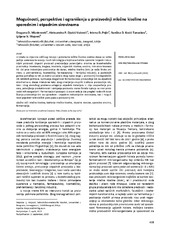Приказ основних података о документу
Opportunities, perspectives and limits in lactic acid production from waste and industrial by-products
| dc.creator | Mladenović, Dragana | |
| dc.creator | Đukić-Vuković, Aleksandra | |
| dc.creator | Pejin, Jelena | |
| dc.creator | Kocić-Tanackov, Sunčica | |
| dc.creator | Mojović, Ljiljana | |
| dc.date.accessioned | 2021-03-10T13:06:29Z | |
| dc.date.available | 2021-03-10T13:06:29Z | |
| dc.date.issued | 2016 | |
| dc.identifier.issn | 0367-598X | |
| dc.identifier.uri | http://TechnoRep.tmf.bg.ac.rs/handle/123456789/3319 | |
| dc.description.abstract | In line with the goals of sustainable development and environmental protection today great attention is directed towards new technologies for waste and industrial by-products utilization. Waste products represent potentially good raw material for production other valuable products, such as bioethanol, biogas, biodiesel, organic acids, enzymes, microbial biomass, etc. Since the first industrial production to the present, lactic acid has found wide application in food, cosmetic, pharmaceutical and chemical industries. In recent years, the demand for lactic acid has been increasing considerably owing to its potential use as a monomer for the production of poly-lactic acid (PLA) polymers which are biodegradable and biocompatible with wide applications. Waste and industrial by-products such are whey, molasses, stillage, waste starch and lignocellulosic materials are a good source of fermentable sugars and many other substances of great importance for the growth of microorganisms, such as proteins, minerals and vitamins. Utilization of waste products for production of lactic acid could help to reduce the total cost of lactic acid production and except the economic viability of the process offers a solution of their disposal. Fermentation process depends on chemical and physical nature of feedstocks and the lactic acid producer. This review describes the characteristics, abilities and limits of microorganisms involved in lactic acid production, as well as the characteristics and types of waste products for lactic acid production. The fermentation methods that have been recently reported to improve lactic acid production are summarized and compared. In order to improve processes and productivity, fed-batch fermentation, fermentation with immobilized cell systems and mixed cultures and opportunities of open (non-sterilized) fermentation have been investigated. | en |
| dc.publisher | Savez hemijskih inženjera, Beograd | |
| dc.relation | info:eu-repo/grantAgreement/MESTD/Technological Development (TD or TR)/31017/RS// | |
| dc.rights | openAccess | |
| dc.rights.uri | https://creativecommons.org/licenses/by-nc-nd/4.0/ | |
| dc.source | Hemijska industrija | |
| dc.subject | Lactic acid | en |
| dc.subject | Lactic acid bacteria | en |
| dc.subject | Waste products | en |
| dc.subject | Industrial by-products | en |
| dc.subject | Fermentation | en |
| dc.title | Opportunities, perspectives and limits in lactic acid production from waste and industrial by-products | en |
| dc.type | article | |
| dc.rights.license | BY-NC-ND | |
| dc.citation.epage | 449 | |
| dc.citation.issue | 4 | |
| dc.citation.other | 70(4): 435-449 | |
| dc.citation.rank | M23 | |
| dc.citation.spage | 435 | |
| dc.citation.volume | 70 | |
| dc.identifier.doi | 10.2298/HEMIND150403050M | |
| dc.identifier.fulltext | http://TechnoRep.tmf.bg.ac.rs/bitstream/id/1245/3316.pdf | |
| dc.identifier.scopus | 2-s2.0-84992017351 | |
| dc.identifier.wos | 000388029400009 | |
| dc.type.version | publishedVersion |

